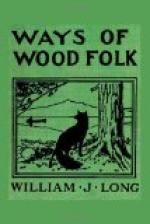Once a farmer, knowing my interest in birds, invited me to come and see a golden-winged woodpecker, which in her confidence had built so shallow a nest that she could be seen sitting on the eggs like a robin. She was so tame, he said, that in going to his work he sometimes passed under the tree without disturbing her. The moment we crossed the wall within sight of the nest, the bird slipped away out of the orchard. Wishing to test her, we withdrew and waited till she returned. Then the farmer passed within a few feet without disturbing her in the least. Ten minutes later I followed him, and the bird flew away again as I crossed the wall.
The notes of the golden-wing—much more varied and musical than those of other woodpeckers—are probably the results of his new free life, and the modified tongue and bill. In the woods one seldom hears from him anything but the rattling rat-a-tat-tat, as he hammers away on a dry old pine stub. As a rule he seems to do this more for the noise it makes, and the exercise of his abilities, than because he expects to find insects inside; except in winter time, when he goes back to his old ways. But out in the fields he has a variety of notes. Sometimes it is a loud kee-uk, like the scream of a blue jay divided into two syllables, with the accent on the last. Again it is a loud cheery whistling call, of very short notes run close together, with accent on every other one. Again he teeters up and down on the end of an old fence rail with a rollicking eekoo, eekoo, eekoo, that sounds more like a laugh than anything else among the birds. In most of his musical efforts the golden-wing, instead of clinging to the side of a tree, sits across the limb, like other birds.
A curious habit which the bird has adopted with advancing civilization is that of providing himself with a sheltered sleeping place from the storms and cold of winter. Late in the fall he finds a deserted building, and after a great deal of shy inspection, to satisfy himself that no one is within, drills a hole through the side. He has then a comfortable place to sleep, and an abundance of decaying wood in which to hunt insects on stormy days. An ice-house is a favorite location for him, the warm sawdust furnishing a good burrowing place for a nest or sleeping room. When a building is used as a nesting place, the bird very cunningly drills the entrance close up under the eaves, where it is sheltered from storms, and at the same time out of sight of all prying eyes.
During the winter several birds often occupy one building together. I know of one old deserted barn where last year five of the birds lived very peaceably; though what they were doing there in the daytime I could never quite make out. At almost any hour of the day, if one approached very cautiously and thumped the side of the barn, some of the birds would dash out in great alarm, never stopping to look behind them. At first there were but three entrances; but after I had surprised them a few times, two more were added; whether to get out more quickly when all were inside, or simply for the sake of drilling the holes, I do not know. Sometimes a pair of birds will have five or six holes drilled, generally on the same side of the building.




